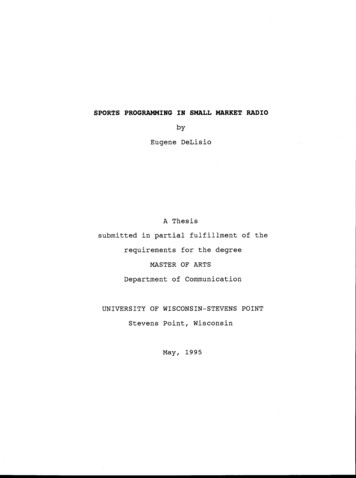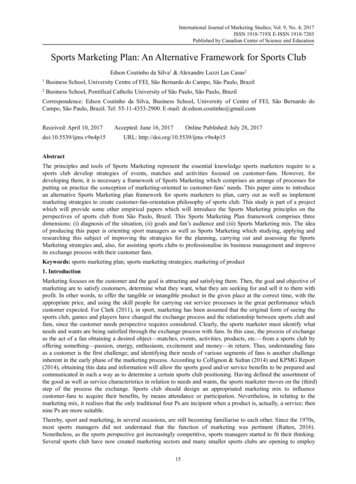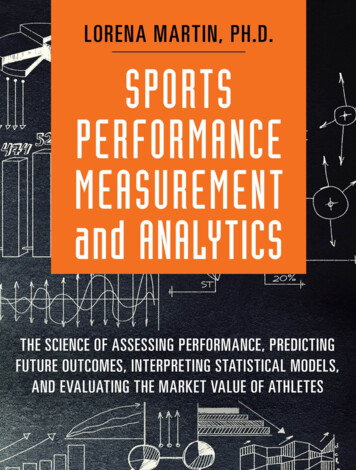
Transcription
SPORTS PROGRAMMING IN SMALL MARKET RADIObyEugene DeLisioA Thesissubmitted in partial fulfillment of therequirements for the degreeMASTER OF ARTSDepartment of CommunicationUNIVERSITY OF WISCONSIN-STEVENS POINTStevens Point, WisconsinMay, 1995
THESIS APPROVAL FORHGraduate School - University of Wisconsin-Stevens PointStevens Point, WisconsinApril 20, 1995DayP.onthDelisio,YearEugeneFirst NameLast Name {Please Print or Type}.Middle1506 South Adams Ave . #111 Marshfield, Wisconsin, , Permanent .Address - Number and StreetCityStateTit 1e of The s i s :Sp or t s P r o gr a mm i n g in Sm a 11 Mark et 8 a d i aomn1 t teeMem er 2 µ- i.· t- Corrrnittee MeThesis approved forCoerhour of credit.Thesis Deposit Deadlines:10 days prior to graduation if student is participating in thecormiencement ceremony.Bythe graduation date if student is not participating in theco1m1encement ceremony.Please return this form to the Dean of the Graduate School.54449Zip
FORMDReport on Ora'l Defense of ThesisTITLE:Sports Programming in Small Market RadioAUTHOR: E u ,g,t.e.; n e D.; e.::.;:: L.::.i.::.s.::.i.::.oHaving heard an oral defense of the above thesis, the Adtiisory Committee:,I ) Finds the defense of the thesis to be satisfactory and accepts the thesis as submitted, subject tothe following recommendation(s), if any:- - 8 ) Finds the defense of the thesis to be unsatisfactory and recommends that tl1e defeme of thethesis be rescheduled contingent upon:\ \,, l \ (f1(I\ c\Date: \\ \(},\ \Committee:2\ . \ - t\1- \ ,. \ ::,. J.;;;.\---'·. \L.l. ------'- -·· ., , Adt isor.\ .:,0C--·Ic -1·t t '-Z //;. hi -L, -
ABSTRACTThis project reviews sports programming at smallmarket radio stations in central and northernWisconsin. The study examines the significance ofsports programming at these stations, what type ofstation broadcasts local sports, and what impact thesebroadcasts have on the stations and their communities.Quantitative information was obtained from radiostations within the survey area, indicating the type ofevents broadcast, the number of broadcasts, teamsbroadcast, and broadcast methods and personnel. Fromthis survey it was determined that virtually all smallmarket radio stations program local sports events,especially on their AM frequencies.The second part of the research program consistedof personal interviews with officials from these radiostations, who discussed what sports programming meansto their radio stations. From this information it wasdetermined that sports programming is an important partof "localism": the way small market radio stationsrelate to their communities. This makes local sportsprogramming a natural fit on small market AM radiostations, which try to use information programming toattract listeners. Many stations, however, shun sportsprogramming on their FM stations, since sportsinterrupts the homogeneity or format integrity of amusic-oriented station. There are exceptions, however,such as FM stations in areas which are underserved byAM radio. Other FM stations broadcast sports to takeadvantage of additional revenue and new listenersdespite the risk to format integrity.The project concludes that sports programming isan important part of a local radio station, not onlybecause of the revenue it produces and the listeners itattracts, but because of the way it allows the radiostation to bind itself to the community. Thisprogramming is especially important in an age ofadditional media competition, when local stations arelooking for ways to give their communities specializedprogramming which cannot be duplicated by other mediaoutlets.
TABLE OF CONTENTSCHAPTER ONE: THE RESEARCH PROJECTINTRODUCTIONORGANIZATIONBRIEF HISTORYRELATED 32DISCUSSIONRECOMMENDATIONSPAGEPAGE139144APPENDIX "A": STATION LISTAPPENDIX "B": MAIL SURVEYGRAPH #1GRAPH #2GRAPH #3GRAPH #4GRAPH 81491501511521531541552459CHAPTER TWO: SPORTS AND RADIOHISTORICAL BACKGROUNDSPORTS ON RADIOSMALL MARKET RADIO SPORTSCHAPTER THREE: THE MAIL SURVEYQUANTITATIVE DATADISCUSSION72CHAPTER FOUR: THE PERSONAL INTERVIEWSQUALITATIVE DATALOCALISMREVENUEHOMOGENEITYTALENTOTHER SPORTSSPECIAL PROGRAMSUNIVERSITIESEXCEPTIONSCHAPTER FIVE: CONCLUSIONS
CHAPTER ONETHE RESEARCH PROJECTINTRODUCTIONSince the early 1900's, when radio became animportant part of the American communications system,sports broadcasting has played an important role inprogramming.From the early days of broadcasting,radio stations have used the broadcast of athleticcontests and sports news as a way to attract audiences,bring important events to the community, and earn aprofit.Today, sports programming still plays a key role,not only for radio networks and large market stations,but also for small radio stations in rural or isolatedareas.In these communities, many listeners tune innot to hear professional sports teams or major collegeathletic squads, but to listen for high school,amateur, semi-pro and even little league teams.This study reviews the local sports broadcastingpractices at a number of small radio stations incentral and northwest Wisconsin.The project examinesthe daily sports operations at these stations to-1-
-2-determine how radio stations schedule, broadcast theirevents, hire their staffs, and to what extent sportsprogramming is emphasized during the broadcast day.The study also seeks answers to more subjectivequestions surrounding sports broadcasts, such astheir significance and impact on the station andcommunity.The author of this work is a sports broadcaster,who has worked in this field for over twenty years.Iserved as Sports Director of a college radio stationwhile obtaining my undergraduate degree in MassCommunication at the University of Wisconsin-Milwaukee.Since graduation I have worked as Sports Director ofradio stations in Cheboygan, Michigan, LaSalle-Peru,Illinois, Rochelle, Illinois, and for ten years priorto finalizing this project, Marshfield, Wisconsin.ORGANIZATIONThis study is divided into a number of sections,designed to give a full report on the small marketradio sports industry in the study area.The first section gives an introduction to thestudy.This section includes a brief historicalstatement and a review of related literature.In thissection, there is also a justification statement, and
-3-a review of the methodological procedures used in thisstudy.The second section presents a historical review ofradio and the sports broadcasting industry.This areagives a synopsis of the history of radio and how sportsbroadcasting became an important part of the medium.This section also focuses on small market radio and howsports programming developed at this level of theindustry.In section three, results of the mail survey arediscussed.Here, there is a review of the quantitativedata compiled in the mail survey, and a presentationof the overall impressions of this data. In thissection, comparisons of data and of station methods areincluded.Section four includes information gathered frompersonal interviews.This includes several specifictopics which have been focused upon following theaccumulation of the quantitative data.Section five includes final assessments and somerecommendations which might be helpful to the industry.This segment also includes suggestions for furtherstudy.
BRIEF HISTORYSports has played a prominent role in thebroadcast industry almost from the inception of radio.In fact, this influence even dates to before the startof our modern radio system.When Guglielmo Marconicame from England to New York in October of 1899 todemonstrate his wireless telegraph, he did so byproviding reports of the America's Cup yacht raceto a New York newspaper.In 1920, a college footballgame was broadcast over Texas Astation, 5XB.&M's experimentalPittsburgh radio station KDKA broadcasta prize fight in April of 1921, and a PittsburghPirates baseball game in August of that year.New Yorkstation WJY signed on in July of 1921 by broadcastingthe heavyweight title fight between Jack Dempsey andGeorges Carpentier.Within the next several years,baseball, football, boxing and other sports important1programming tools for many radio stations.In the early years of radio, most stations wereconfined to large, metropolitan areas.There were 5702radio stations in the United States in 1925.This1- John Hitchcock, Sportscasting: A Practical Guideto Success, (unpublished manuscript, date unknown)p. 3.2- Christopher H. Sterling and John M. Kittross, StayTuned: A Concise History of American Broadcasting,(Belmont, California: Wadsworth, 1978), p. 92.-4-
-5-34number increased to 618 in 1930, 765 in 1940, and 9715in 1945.Few of these stations, however, were locatedin rural or underpopulated areas.By 1945, the onlyradio stations on the air in northern Wisconsin were inAshland, Eau Claire, Medford, Rice Lake, Superior,6Wausau and Wisconsin Rapids.After World War II, whenmany smaller communities began to obtain radio service,it was only natural that they also provide sportscoverage as a way to emulate successful large stationsand to localize their programming for the area theywished to serve.RELATED LITERATUREIn reviewing literature for this topic, little isfound concerning the combination of sports broadcastingand small market radio.In fact, few studies have beencompleted on small market radio at all.Most radiostudies concern large markets, and many of them discussmusical formats or news content.Studies on sportsbroadcasting usually focus on one of two topics: theinfluence of lucrative broadcast contracts onprofessional and major college sports, or the effect of3456-ibid., p. 135.ibid., p. 197.ibid., p. 243.The 1977 Broadcasting Yearbook lists the sign-ondates for all radio stations in the United States.
-6-televised sports "violence" (football, boxing orhockey) on the viewer.The first reference source for a paper such asthis would seem to be Broadcasting magazine.This isconsidered a leading trade magazine of the industry,but searches in this publication show little on thistopic.Broadcasting reports on timely developments inthe industry, which often occur in the governmentalarena, among networks or corporate owners, or inindustry trends which influence readily seen largemarkets.Few new developments occur at the smallmarket level, and those that do often do not affectindustry leaders enough to warrant coverage.There are some books on sports broadcasting whichassist this study in limited ways.One is written bysmall market sportscaster John Hitchcock,Sportscasting: A Practical Guide to Success.Hitchcock's book details some of the fundamentals ofthe sportscasting industry.It deals with play-by-play and other aspects of the job such as reporting,writing, interviewing and even selling advertising.A similar book was written by longtime Boston RedSox and NBC sportscaster Ken Coleman.It is So YouWant to be a Sportscaster and provides much the sameinformation as the Hitchcock book, although not as
-7-detailed.This book also places more emphasis on play-by-play, while interweaving Coleman's personalexperiences.During the historical review segment of the paper,attempts are made to describe the condition of smallmarket radio sports broadcasting in the earlier days ofthe industry.In their books, Coleman and Hitchcockdiscuss those early years.Coleman especially draws onhis experiences and those of other broadcasters, andrelates the condition of small market radio sports inthe 1940's and before.Some of these experiences arevery helpful in the historical segment.Another historical source is The Broadcasters,written by Baseball Hall of Fame broadcaster RedBarber.Barber also writes about broadcasting from ahistorical perspective.Barber's book, however, dealsmainly with broadcasting on the network and majorleague level, and includes little about small markets.Longtime New York Mets broadcaster Lindsey Nelsonhas written two books, mostly about his ownexperiences.They are, Backstage at the Mets and HelloEverybody, I'm Lindsey Nelson.These books alsoinclude historical looks at sports broadcasting.LikeBarber, however, Nelson spent little of his career insmall markets, so most of his writing concerns networks
-8-and the major leagues.Game by Curt Smith.A similar book is Voices of theThis is a historical review ofmajor league baseball broadcasting, but has littlediscussion of small market radio.Another interesting source is You're on the Air,written by Graham McNamee in 1926.McNamee was one ofthe early greats of radio, and broadcast many sportsevents in the 1920's.He was one of the firstsportscasters, and developed his skills without thebenefit of predecessors.McNamee provides insights inthis historical perspective and gives valuableinformation on some other areas, such as earlytechnology.McNamee, however, also broadcast hisentire career in large markets and at the networklevel, and also worked his entire career when therewere very few small market radio stations.In conclusion, there is little in the literaturewhich aids the main topic of this study.There aresome works which help in peripheral areas, but most ofthe information collected for this study comes fromother primary sources.
JUSTIFICATIONThere are several reasons why a study of this typeis justified.One is that, in reviewing past research,little is found concerning small market radio.Muchresearch has been done on radio in larger markets, orother media, yet a large segment of the populationlives in rural communities which are served by smallmarket radio stations.This project presents a uniqueopportunity to use academic research to explore therelationship between these radio stations and theirlisteners.Such outlets serve a large segment ofsociety, which warrants a review of their methods andtheir work.As mentioned above, there is much researchavailable on radio in larger markets, and it is truethat these stations reach more listeners.Because ofthe nature of small town radio and its reliance uponlocal involvement, local radio may, however, have moreof an impact on the lives of its listeners than largemarket stations.Big city stations may rely on strictmusic formats which entertain listeners, but rarelyinfluence their lives.Small market radio is muchdifferent because of its presentation of community newsand events which directly effect local residents.-9-This
-10-would make the study of small market radio, which hasthe potential to influence a large segment of society,very valuable.Not only will such a study lead to better understanding of small market radio, but it may also lead tobetter understanding of the audience these stations tryto reach.Most radio stations make an effort to learnas much about their audience as possible.This studycould lead to a profile of the small market radioaudience and more understanding of its needs.This study could also be very beneficial tobroadcasters.Broadcasters may concentrate on theirown markets so much that they may not be aware of whatother stations do in similar positions.This study maygive broadcasters a chance to compare ideas in a veryimportant part of their station's operation.An ideathat springs from one station in one area could lead toits development as an important tool for many otherstations.This project may also give a condensed view of animportant part of the radio industry.There may bemany hypothesis as to why radio stations broadcastsports events, but this study will report the actualreasons behind this programing.This study will alsoprovide many of the details of sports programing in
-11-small markets, give an overview to this segment of theindustry, and report some standards in the business.There will also be some comparisons between stationdifferences.From a broadcaster's viewpoint, such astudy could be a valuable tool for serving the localcommunity and making future decisions.METHODOLOGYMost information for this study was gathered fromtwo sources; a mail survey and personal interviews withradio station personnel.Initial quantitative data wasobtained with a mail survey, with additionalinformation provided by follow-up interviews.Although many researchers have conducted projectsaimed at the media, this project is unique in severalways.First, this study is aimed at small market*radio, and searches show no previous projects in thisarea.Second, this study is aimed at the radiostations themselves and not the audience.There aremany research projects concerning the broadcast media,*- There seems to be no accepted industry definitionof "small market radio", but this term is usuallygiven to small cities with a single radio stationowner/operator. All of the stations in this studyare listed in the Standard Rate and Data SpotRadio Small Market Edition, October, 1989.
-12-but most deal with audience reaction to commercials,violence, news or some other aspect of programming. Forthese topics, research methods such as contentanalysis, attitude measurement (Semantic Differentialand Likert Scales), agenda setting and others are quiteappropriate.data.This study, however, uses descriptiveA mail survey, asking simple questions about thecurrent condition of the station's sports programming,is, therefore, the best method for obtaining initialinformation.The first priority of the project was to select asample.Since the study focuses on sports programmingin small market radio, and since the study was done incentral Wisconsin, radio stations in this area wereused.The study primarily focused on radio stationswhich broadcast sports in two northern Wisconsin highschool leagues: the Wisconsin Valley and LumberjackConferences.The 15 radio stations which broadcastsports in these conferences include cities varying inpopulation from 3,100 to 37,000.These stations reacha large audience throughout central, northeast andnorthwest Wisconsin.Many of these communities areserved by AM/FM combo operations; that is, stations ina particular market which are owned and operated by asingle firm.Other stations, in markets larger and
-13-smaller than those in these two conferences, were alsoon the survey list because of their unique location ortheir programming practices, and because informationobtained from these stations provided information whichcould be compared to the other stations.A list of thesurvey stations may be found as Appendix A.A list of radio stations in the survey area wasobtained from Broadcasting Yearbook.Surveys were sentto the highest ranking station officer who is likely tobe on the premises on a daily basis.A stationPresident or Chairman of the Board, for example, may bea corporate owner who is removed from the day-to-dayoperation, or could be based in another city.AGeneral Manager of Station Manager was likely to be atthe station most days.If a person with one of thosetitles was not found through Broadcasting Yearbook,surveys were sent instead to another person who holdssome authority within the station structure, such as anOperations Manager, Program Director or News Director.The survey (Appendix B) was one-page and requiredno more than 10 to 15 minutes to complete.Stationcall letters were filled in at the top of each surveybefore mailing.Many of the stations which receivedsurveys are combo stations (co-owned AM/FM stations inthe same market).In these instances, two surveys were
-14-sent, with one for each station.Stations were askedwhat local sports events they broadcast, and whichlocal teams they broadcast as primary and secondaryteams.*Stations were also asked how many localevents they broadcast each year, methods used tobroadcast events, and also asked to identify theirbroadcast personnel.There was also a brief listing oftimes and lengths of locally produced sports reports.The quantitative data obtained from this mail surveyproduced an information base for the personalinterviews.One of the aims of the survey was to find radiostations which broadcast games involving one school,and only broadcast high school football and boysbasketball.This is why the first option for numberof events broadcast is 0-30, since a station whichbroadcast only these games would broadcast about 30events per year.*- Primary teams usually represent the station's cityof license, and most of their games are broadcast,although some may be missed due to conflicts orspecial programs.Secondary teams usuallyrepresent communities outside of the city oflicense and are broadcast when the primary teamsare inactive. For example, at WDLB, Marshfield,Wisconsin, Marshfield Senior High School andMarshfield-Columbus High School are primary teams,while nearby Auburndale High School is a secondaryteam. A primary team usually has at least 90% ofits games on the air. A secondary team may have50% or more of its games broadcast, but still,only when the primary teams are inactive.
-15-As mail surveys were returned, each was coded withthe date and numbered sequentially.Stations were thencompared by the number of events broadcast, and thenumber and length of sports reports. Other data, suchas personnel or teams broadcast were also listed, withdeviations from the norm noted (i.e., stations whichbroadcast a game of the week concept which involves anumber of teams rather than a primary team).The evaluation process included listing allrespondents and their answers to each question.Inreviewing quantitative data, such as number of gamesbroadcast, median and average numbers were determinedand there are notes on stations whose practices deviatewidely from other stations.The information obtainedfrom these surveys not only gives a statistical view ofsports broadcasting in the target area, but alsoprovides reference information which was quite usefulduring the personal interview process.Of course, not all radio stations are involved inlocal sports broadcasting.Although it appears thatlocal sports is a primary source of programming formany small market stations, some decide not toparticipate in this type of programming.Surveys werealso sent to these stations, and interviews withrepresentatives of these stations were very useful in
-16-explaining why some stations do not broadcast localsports.Surveys were sent to 29 radio stations in Novemberof 1993.Between November 21 and December 23, 21surveys were returned (72%).A second mailing to non-responding stations in mid-December resulted in oneadditional returned survey in early January of 1994,bringing the number of respondents to 22 (76%).Athird mailing was not used because of the heavy volumeof response from the first mailing, and because priorresearch indicates that more than two or three mailings7are usually ineffective.The mail survey provided this study with a numberof advantages.It covered a wide region at a nominalcost, and enabled the project to obtain informationfrom persons who would normally be difficult to reachbecause of their locales and schedules.The mailsurvey also allowed direct contact with top officialsof stations in the sample.Questions in the mailsurvey were short and concise, leading to answers whichcould either be checked in boxes or completed in a fewshort words.The mail surveys also allowed allrespondents to answer the same questions, providing for7- Roger Wimmer and Joseph Dominick, Mass MediaResearch: An Introduction, (Belmont, California:Wadsworth, 1991), p. 122.
-17-8an exact standard measurement.More subjective answerswere obtained in the personal interviews whichfollowed.There are disadvantages to mail surveys, notablyin the possibility of low response rates.Researchersindicate that some mail surveys feature low return9rates of about 20 to 40-percent.Others suggest thatresponse rates of SO-percent are adequate while 7010percent is very good. This project was very fortunate,therefore, to achieve its high return rate of nearly80-percent.As the quantitative data from the mail survey wasobtained, the information was examined, and areas ofinterest such as methods, personnel and number and typeof events began to emerge.This information was veryhelpful during the personal interview process and washighlighted during these visits along with moresubjective subjects such as impact, role and policy ofsports broadcasting.8- ibid., p. 123.9- ibid.10- Earl Babbie, The Practice of Social Research:Fifth Edition, (Belmont, California: Wadsworth,1989), p. 242.
CHAPTER TWOSPORTS AND RADIOHISTORICAL BACKGROUNDAlthough radio has been with us only since theearly portion of this century, the idea ofinstantaneous communication dates back much further.Experiments using sea water to conduct messages weremade as early as 1795.The actual birth ofbroadcasting might date back to 1832 when11Samuel Morse began work on the telegraph.This devicewas in use by the middle of the following decade, andtelegraphy was common by the 1850's.The first use of point-to-point communication viavoice was achieved by Alexander Graham Bell, who12invented the telephone in 1876. While Bell worked onwire communication, however, other inventors workedwith wireless telegraphy.German physicist HeinrichHertz, building upon theories first suggested byScottish mathematician and physicist James ClerkMaxwell 25 years earlier, proved the existence of radiowaves in 1888, causing a public sensation.Visionaries11- Sterling, p. 812- Erik Barnouw, A History of Broadcasting in theUnited States, 3 vols. (New York: Oxford, 1966),volume 1, p. 7-18-
-19-could foresee a day when waves could produce telegraphy13without wires, cables or other unwieldy apparatus.Italian Guglielmo Marconi worked on Hertz's ideasat his father's estate near Bologna, and produced adevice which could send and receive signals up to two14miles. Marconi moved to London to continue his work.In 1896, he sent a message nine miles, and in 1901, heused Morse Code to send the letter 'S' across the15Atlantic Ocean. Marconi founded the Britishand American Marconi Companies, which producedtransmitting and receiving equipment around the world.Canadian Reginald Fessenden made the firstwireless experiments in America.His first were forthe Department of Agriculture in 1900 and 1901, and helater worked on his own at Brant Rock, Massachusetts.There, Fessenden made the first radio broadcastdesigned for a large, general audience when hebroadcast a program of speech and music on December24, 1906.The program was designed for crews of shipsat sea and was heard as far away as Norfolk.A similar16program a week later was heard in the West Indies.13- ibid., p. 9.14- Sterling, p. 25.15- Ken Burns, Empire of the Air: The Men Who MadeRadio, (Pioneer Film Project, Inc., 1991).16- Helen M. Fessenden, Fessenden: Builder ofTomorrows, (New York: Coward-Mccann, 1940), pp.145-154.
-20-American Lee de Forest also made contributions toearly radio, first experimenting by transmitting from17the roofs of Chicago hotels in 1901. de Forestpopularized his wireless machine with publicexhibitions, broadcasting from the St. Louis World'sFair in 1904 and from the Eiffel Tower in Paris in1908.The latter program was reportedly heard up18to 500 miles away. de Forest also invented the audiontube, which allowed for improved reception of radiosignals.This tube became an important aspect inradio's development, especially after work by EdwinHoward Armstrong, which improved the tube's receptionpower and also allowed it to transmit.Armstrong andde Forest both claimed credit for developing the tube,and the two became involved in the country's longest19patent suit over ownership of the audion.In the decade prior to World War I, more advanceswere made in wireless technology, and more amateuroperators, or "hams", became involved in radio.Whenthe United States entered the War, there were as manyas 5000 operators in this country, and about twice thatmany when the war ended.17- Barnouw, p. 23.18- Sterling, p. 29.19- Burns.These early broadcasters
-21-built their own sets and primarily talked to and20listened to one another.Many early radio experiments occurred at colleges.Charles D. "Doc" Herrold broadcast a regular program ofnews and music from the College of Engineering andWireless in San Jose, California as early as 1909.This station, which later evolved into KCBS in SanFrancisco, was heard over speakers which Herrold21constructed and placed in hotel lobbies. Experimentsalso took place at the University of Wisconsin-Madison,where Professor E.M. Terry began station 9XM in 1917 tobroadcast weather forecasts and market reports.Thisstation later changed its call letters to WHA, andsince it was one of the few stations allowed to remainon the air during the war, its continuous operationgives it a legitimate claim to being the first radiostation in America.This station, however, broadcast22all of its reports in Morse Code until 1919.Prior to World War I, most per ons involved withradio considered it as a means to broadcast from pointto point.They saw radio as one person transmitting toone other person.Others saw radio as something else.As early as 1914, de Forest had his own radio studio in20- Lloyd R. Morris, Not So Long Ago,Random House, 1949), p. 433.21- Sterling, p. 40.22- ibid., p. 42.(New York:
-22-New York, with which he broadcast programs of music andnews, designed for a mass audience.David Sarnoff alsobelieved in the concept of a mass audience for radio.Sarnoff's idea was the "Radio Music Box", which hedeveloped as early as 1916.Sarnoff wrote Marconi thatradio should be considered a household utility, asnecessary as furniture or a telephone.He envisionedthe Marconi Company manufacturing sets for the generalpublic, and selling 100,000 per year at 75.00 apiece.Marconi executives rejected this proposal, however, and23the mass radio concept did not truly evolve until 1920.After World War I, a Westinghouse engineer, Dr.Frank Conrad, operated a station in his Pittsburghga
THESIS APPROVAL FORH Graduate School - University of Wisconsin-Stevens Point Stevens Point, Wisconsin April 20, 1995 P.onth Day Year Delisio, Eugene Last Name {Please Print or Type} First Name .Middle 1506 South Adams Ave . #111 Marshfield, Wisconsin , , Permanent .Address - Number and Street City State Tit 1 e of The s i s : Sp or t s P r o gr a mm i n g in Sm a 11 M ark et 8 a d i a











